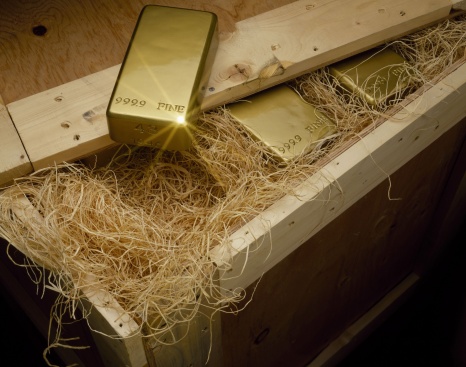Commodities & Metals
How to View and Value Gold in a Rising Dollar Environment
Published:
Last Updated:
It is almost impossible to argue against the notion that gold has lost much of its luster for investors and speculators. Gold may not have fallen out of favor as badly and quickly as oil, but the shiny yellow stuff has lost more than one-third of its dollar-based value from the $1,900 peak back in 2011. With so many central banks involved in new rounds of quantitative easing, it is important for investors and speculators to consider how gold will act in a rising dollar environment.
It is widely expected that the U.S. Federal Reserve is about to raise interest rates, due to relative economic strength and also as a return to normalcy in interest rates. Simultaneously, negative interest rates are seen in Europe and elsewhere, as is central bank asset buying. It almost seems to be a self-fulfilling prophecy that this will be a strong U.S. dollar environment ahead.
So, how should speculators and investors expect gold to perform in a rising dollar environment? The World Gold Council has laid out its views. Frankly, the concerns might not be as strong as many might suspect.
ALSO READ: Fed Push for Inflation Implies Support for Gold Price, Miners
While you would expect that a group dedicated solely to the promotion and longevity of the gold industry to be positive, this report actually looks pretty fair and balanced, when you get past the points made that gold remains relevant for portfolios. The World Gold Council said about gold versus a rising dollar:
Generally, there is an inverse correlation between gold and the dollar. However, our analysis shows that the gold price increases more when the dollar weakens than it falls when the dollar strengthens. In our view, the dollar’s relationship with gold has changed dramatically over the past decades and is likely to shift further as demand moves East and the world moves to a multicurrency system.
The council further went on to point out that the relationship between gold and the dollar is asymmetrical. In other words, the dollar and gold fail to correspond to each other. Between early 2014 and March 20, 2015, the U.S. dollar rose by 20% while gold only fell by 1.2%. The council pointed out that gold prices historically rise more than double on a weak dollar than it falls on a strong dollar. More specifically, it said:
ALSO READ: Will Gold Follow Oil and Fall Back Under $1,000?
The council suggested that gold improves portfolio performance even in the face of a rising dollar. It uses a 4% allocation on a 60/40 portfolio (60 stocks, 40 bonds) — at a time when stocks and bonds may deliver lower than average returns in the coming years. On how the relationship to the dollar has changed of late, since the year 2000 the U.S. dollar’s share of global reserves has fallen to 55% from 61%. Another issue brought up is that the market may be wrong about gold and U.S. interest rates. The council said:
Many investors believe that higher US interest rates will be certainly bad for gold. Our analysis shows that other factors — some positively correlated to the economic growth that often accompanies rising rates — can have more influence on the gold price.
As far as the key gold exchange-traded product (ETP), shares of the SPDR Gold Trust (NYSE: GLD) were up 0.7% at $115.55 on Thursday, against a 52-week range of $109.67 to $129.21. The SPDR site showed that it held 743.21 tonnes of gold. This is down from 750.67 tonnes just 10 days ago and from 773.30 tonnes on February 12. Now go back almost two years, to April of 2013, and this ETP had some 1,154.34 tonnes, worth $51.75 billion at that time — the value of the SPDR Gold Trust is currently counted as $28.56 billion. Kitco showed that spot gold was up over 0.8% at $1,205 in mid-morning trading on Thursday.
One key issue that of course has to play a part in future pricing of gold, outside of currencies and interest rates, is the supply-side economics of gold mining. This notion was not a part of the World Gold Council’s published report, but 247 Wall St. would urge readers to keep this one factor in mind on top of the U.S. dollar and rising interest rates. A huge drop in oil is likely to help that on the input costs of extracting gold, but rising wages may offset that. Anyhow, in order to show both sides of the coin, this is something that has to be considered ahead.
ALSO READ: Are Steel and Metal Stocks Forming a Bottom?
The thought of burdening your family with a financial disaster is most Americans’ nightmare. However, recent studies show that over 100 million Americans still don’t have proper life insurance in the event they pass away.
Life insurance can bring peace of mind – ensuring your loved ones are safeguarded against unforeseen expenses and debts. With premiums often lower than expected and a variety of plans tailored to different life stages and health conditions, securing a policy is more accessible than ever.
A quick, no-obligation quote can provide valuable insight into what’s available and what might best suit your family’s needs. Life insurance is a simple step you can take today to help secure peace of mind for your loved ones tomorrow.
Click here to learn how to get a quote in just a few minutes.
Thank you for reading! Have some feedback for us?
Contact the 24/7 Wall St. editorial team.